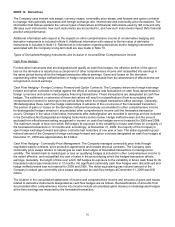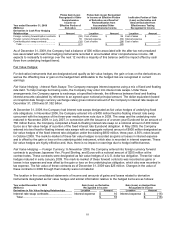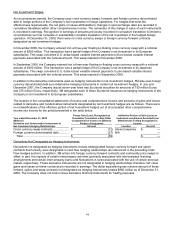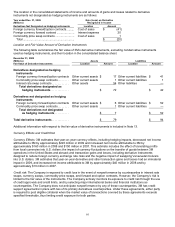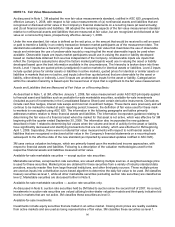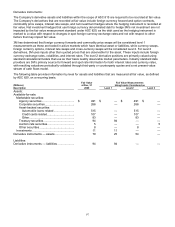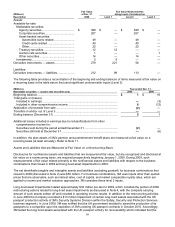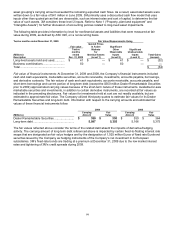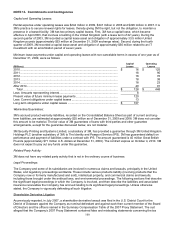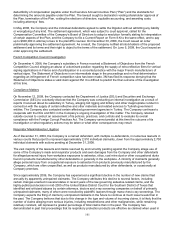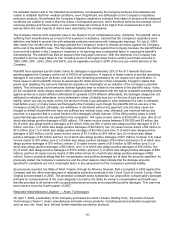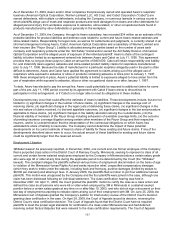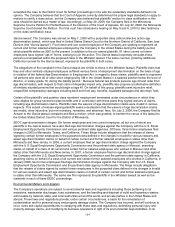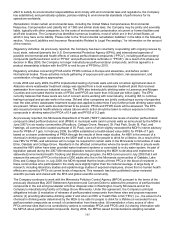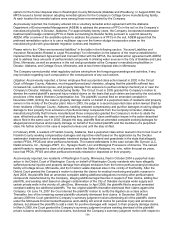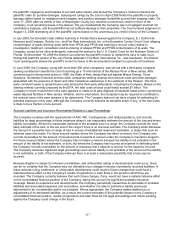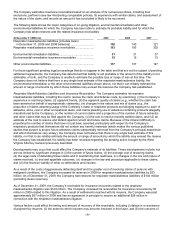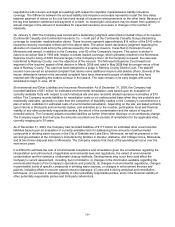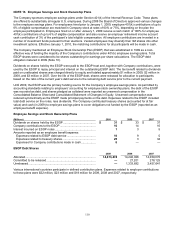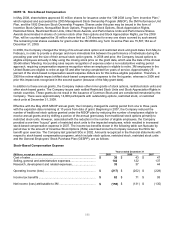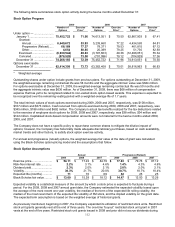3M 2009 Annual Report Download - page 108
Download and view the complete annual report
Please find page 108 of the 2009 3M annual report below. You can navigate through the pages in the report by either clicking on the pages listed below, or by using the keyword search tool below to find specific information within the annual report.
102
the intended manner and in the intended circumstances. Consequently the Company believes that claimants are
unable to establish that their medical conditions, even if significant, are attributable to the Company’s respiratory
protection products. Nonetheless the Company’s litigation experience indicates that claims of persons with malignant
conditions are costlier to resolve than the claims of unimpaired persons, and it therefore believes the average cost of
resolving pending and future claims on a per-claim basis will continue to be higher than it experienced in prior
periods when the vast majority of claims were asserted by the unimpaired.
The Company tried its ninth respirator case in the Superior Court of Alameda County, California. The plaintiff, who is
suffering from mesothelioma as a result of his exposure to asbestos, claimed that the Company’s respirators were
defective and failed to provide him with adequate protection and came with inadequate warnings. On July 6, 2009,
after nearly four months of trial, the judge granted the Company’s motion to dismiss all claims against the Company
at the end of the plaintiff’s case. The trial judge dismissed the claims against the Company because the plaintiff failed
to prove that a defect in the Company’s respirator or its warnings was a substantial factor in causing the plaintiff’s
mesothelioma. The plaintiff has filed an appeal of the trial judge’s decision. With this dismissal, the Company has
prevailed in all nine cases taken to trial, including seven of the eight cases tried to verdict (such trials occurred in
1999, 2000, 2001, 2003, 2004, and 2007), and an appellate reversal in 2005 of the one jury verdict adverse to the
Company.
Plaintiffs have asserted specific dollar claims for damages in approximately 32% of the 913 lawsuits that were
pending against the Company at the end of 2009 in all jurisdictions. A majority of states restrict or prohibit specifying
damages in tort cases such as these, and most of the remaining jurisdictions do not require such specification. In
those cases in which plaintiffs choose to assert specific dollar amounts in their complaints, brought in states that
permit such pleading, the amounts claimed are typically not meaningful as an indicator of the Company’s potential
liability. This is because (a) the amounts claimed typically bear no relation to the extent of the plaintiff’s injury, if any;
(b) the complaints nearly always assert claims against multiple defendants with the typical complaint asserting claims
against as few as a dozen different defendants to upwards of 275 different defendants, the damages alleged are not
attributed to individual defendants, and a defendant’s share of liability may turn on the law of joint and several
liability, which can vary by state, and by the amount of fault a jury allocates to each defendant if a case is ultimately
tried before a jury; (c) many cases are filed against the Company even though the plaintiffs did not use any of the
Company’s products and, ultimately, are withdrawn or dismissed without any payment; and (d) many cases are
brought on behalf of plaintiffs who have not suffered any medical injury, and, ultimately, are resolved without any
payment or a payment that is a small fraction of the damages initially claimed. Of the 288 pending cases in which
purported damage amounts are specified in the complaints, 144 cases involve claims of $100,000 or less, (five (5) of
which also allege punitive damages of $20 million); 104 cases involve claims between $100,000 and $3 million (six
(6) of which also allege punitive damages of $1 million, thirty-six (36) of which also allege punitive damages of $1.5
million, and one (1) of which also allege punitive damages of $2 million); four (4) cases involve claims of $3 million to
$7.5 million (one (1) of which also allege punitive damages of $5 million and one (1) of which also allege punitive
damages of $25 million); six (6) cases involve claims of $7.5 million to $10 million (two (2) of which also allege
punitive damages of $5 million and four (4) of which also allege punitive damages of $21 million); fourteen (14) cases
involve claims of $10 million (one (1) of which also allege punitive damages of $5 million and seven (7) of which also
allege punitive damages of $10 million); eleven (11) cases involve claims of $10 million to $50 million (one (1) of
which also allege punitive damages of $5 million, one (1) of which also allege punitive damages of $15 million, five
(5) of which also allege punitive damages of $15.5 million, and one (1) of which also allege punitive damages of $20
million); and five (5) cases involve claims of $50 million (three (3) of which also allege punitive damages of $50
million). Some complaints allege that the compensatory and punitive damages are at least the amounts specified. As
previously stated, the Company’s experience and the other reasons cited indicate that the damage amounts
specified in complaints are not a meaningful factor in any assessment of the Company’s potential liability.
As previously reported, the State of West Virginia, through its Attorney General, filed a complaint in 2003 against the
Company and two other manufacturers of respiratory protection products in the Circuit Court of Lincoln County, West
Virginia and amended it in 2005. The amended complaint seeks substantial, but unspecified, compensatory damages
primarily for reimbursement of the costs allegedly incurred by the State for worker’s compensation and healthcare
benefits provided to all workers with occupational pneumoconiosis and unspecified punitive damages. This case has
been inactive since the fourth quarter of 2007.
Respirator Mask/Asbestos Litigation — Aearo Technologies
On April 1, 2008, a subsidiary of the Company purchased the stock of Aearo Holding Corp., the parent of Aearo
Technologies (“Aearo”). Aearo manufactures and sells various products, including personal protection equipment,
such as eye, ear, head, face, fall and certain respiratory protection products.


